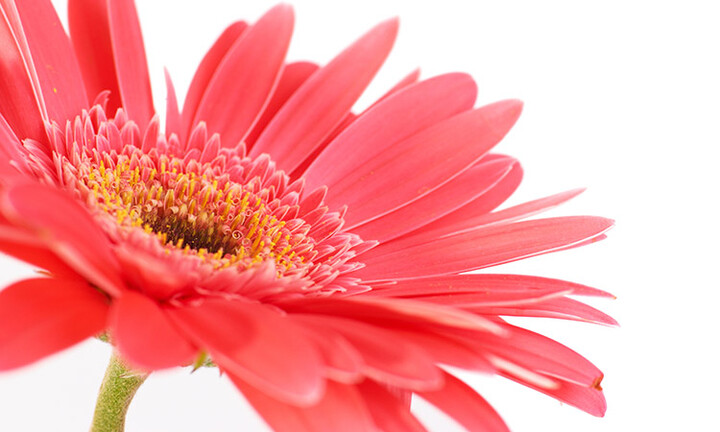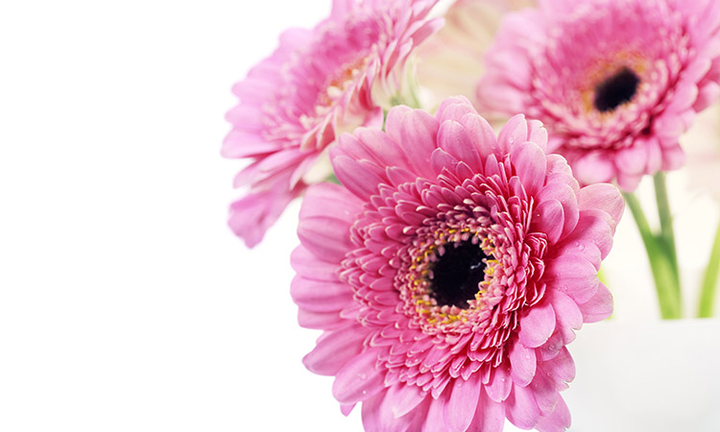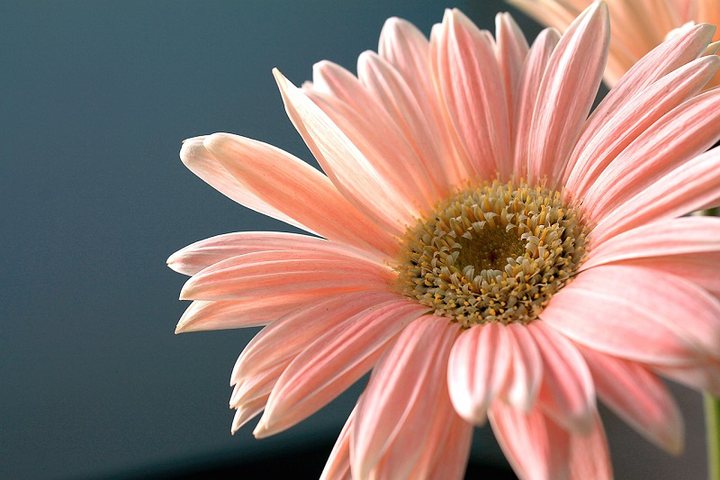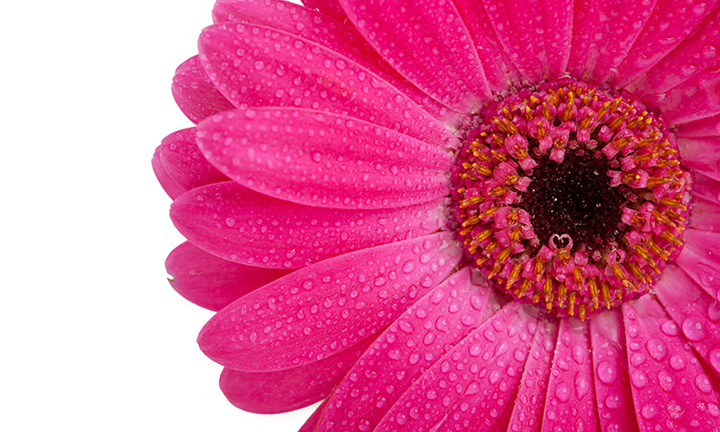
Gerbera flowers are some of the most popular blooms in the world. They originate from North America, belong to the Asteraceae family (the same family as sunflowers and daisies) and were discovered in the early 1920s.
Similar to sunflowers, they trail the direction of the sun from East to West. They also boast an excellent vase life, which makes them a great option for cut flowers.
Types of Gerbera flowers
The Netherlands alone produces almost 900 million of the Gerbera flower species per year. Some of these include:
Double Gerbera Daisies
These double-petaled flowers comprise not only doubles but crested and full-crested assortments. They feature one or two rows of petals, which are nicknamed ray flowers, as well as a dense group of disk flowers, which sit in a central position.
Gerbera Apricot
This particular species of Gerbera is native to South Africa, and offers an attractive appearance, which means it makes for an ideal ornamental plant. The large petals are tinged apricot and pink and boast yellow, golden centers. For best results, place in full sunlight and use moist, well-drained soil.
Gerbera Aurantiaca
This daisy, with its lengthy, pointed petals, is a little different to the majority of Gerbera flowers. The petals are hot red in hue and feature a dark center, complete with large, bright-green leaves. They thrive in moist but well-drained soil, and create an eye-catching focal point, meaning they are perfectly suited to containers and pots.
Gerbera Hybrida (Gerbera Fiction Beige with Pink Centric)
With their beautiful, creamy, white and beige petals, which feature stunning flashes of raspberry-pink throughout, it is little wonder this plant is a popular option for both the home and garden. The plant itself is compact and sturdy and grows to one foot in height. As a result, it’s the ideal option for containers, bouquets, and garden borders.
Gerbera hybrida (Orange Gerbera Daisy)
With its arresting bright-orange hue and large, showy appearance, this perennial flower is a popular ornamental plant. The plant reaches about one foot in height and is equally as striking in the garden as it is in a vase or bouquet.

Growing Gerbera at home in the garden
Often referred to as the Transvaal daisy, this species comes in a range of jewel tones. The impressive flowers grow on top of single, tall stems, accompanied by mounds of somewhat fuzzy leaves. At full growth, Gerbera daisies boast an impressive height of eight to 24 inches. They are traditionally grown as annuals and as bedding plants. For best results, plant when all danger of spring frosts have passed.
To prepare for planting, use a spade and dig a hole measuring between eight and ten inches deep, and place between one to two inches of organic matter (such as compost or manure) in the ground. Gerbera daisies tend to prefer bright sunlight, however, if you live in a warmer climate, opt for a position that benefits from afternoon shade.
If planting several plants, space between 18 to 24 inches apart and ensure that the crown of the plant (where the main stem meets the roots) is positioned a little above ground level. This will prevent the plant from suffocating. Water the plant on a regular basis when in bloom and soak the roots thoroughly. Before the next watering, allow the top of the soil and the crown of the plant to dry out completely.
To ensure optimal growth, fertilize Gerbera daisies on a monthly basis throughout the growing season. For best results, use a general-purpose, balanced garden fertiliser. Another option is to apply a time-release fertiliser every six to eight weeks.
During the growing season, the ideal temperature for Gerbera is between 10°C and 20°C (50-68°F) and a number of hardier species can flower all-year-round provided that temperatures do not regularly drop below 10°C.
When spring arrives spread between one and two inches of natural mulch, such as compost or shredded bark, around the plant. You should also remove blooms as soon as they begin to wilt, as this will stop the plant from setting seed too early in the season. To prune Gerbera daisies, pinch or remove the wilted bloom using a sharp knife or scissors.
In most cases, you will need to replant Gerbera daisies in autumn every other year.
Common diseases of Gerbera
The Gerbera is susceptible to a number of diseases, the majority of which can be controlled. These include:
Powdery Mildew
This fungal disease is the most prevalent gerbera disease. It’s caused by high humidity, moderate temperatures, and cloudy weather. Affected plants will showcase small blotches of a powdery, white substance, which will appear on the flowers and lower leaves.
Botrytis Blight
Also known as gray mildew, this particular ailment is caused by a type of mould fungus (Botrytis cinerea). This often occurs during periods of cool, rainy weather. Affected plants will develop a grey, fuzzy growth that comprises a number of fungal spores.
Black Root Rot
Black root rot (Thielaviopsis basicola) harms the gerbera plant’s root system. Signs include wilting leaves and yellowing of new growth. Certain plants will develop black stem lesions, which appear at the soil line.

Disease Prevention
With proper plant care, the majority of gerbera diseases can be avoided. For best results, plant in well-drained soil and water only when the top of the soil surface is dry. Ensure correct air ventilation by allowing enough space between each plant and disinfect potting media to eliminate any infectious organisms. Diseased gerbera daisies should also be removed from the locality of other plants immediately.
Colors available
There are a variety of Gerbera hues to choose from, including hot pink, fuchsia, bright white, dark red, pastel pink, bold orange, magenta, light yellow, deep gold, and peach. The majority of Gerbera daisies also contain a variety of shades within a single flower, which makes them even more appealing. The centers are often black or dark in color. Given the wide range of hues, they’re a popular flower for bouquets.
Planting guide for Gerbera
It’s possible to grow gerbera daisy plants from division, seed or seedlings. Seed is the most cost-effective method. However, seeds must be sown instantly as they lose viability rapidly post opening. Opting for seedlings is an easier method, whilst choosing divided plants will ensure the flower type. If you have more mature plants, the crowns can be elevated and divided in the months of early spring. For best results, prune the lower leaves and replant straightaway.
Basic care
Gerbera daisies are vulnerable to a number of fungal diseases, especially younger plants. With this in mind, the correct planting and watering methods are essential for gerbera daisy care.
Gerbera plants prefer to grow in a position that benefits from full sunlight and sandy soil. To encourage flower growth, add a little compost post planting. If you have sown new seeds, it’s a must that you use a well-draining propagation mix, and plant in a location that boasts bright, indirect light.
Planting the crowns too deeply can cause root rot. It’s therefore important to ensure the crown is visible above the soil and it needs to be dry to the touch in-between watering. For best results, water in the morning so leaves dry out during the day – this will lessen the risk of fungal diseases and rot. In addition to diseases, these plants can be susceptible to insects such as caterpillars and leaf miners. Use an organic spray such as neem oil or pyrethrum to deter such bugs.
Plants can be mulched, but it’s wise to ensure the mulch doesn’t cover the crown. If you reside in a humid or wet climate or plant in an area with heavy soil, use well-draining pots to ensure optimum growth.
Spacing the plants adequately apart and in good light is a great way to make sure they thrive. Without direct sunlight, the gerbera plants tend to get leggy and turn pale in color. If this happens, it’s unlikely to produce as many blooms. To further enhance gerbera daisy growth, use a micro-nutrient liquid fertilizer such as a fish emulsion or seaweed.

Meaning of Gerbera
Gerbera Daisies boast several meanings, and all lean towards feelings of happiness. The Egyptian meaning is symbolic of nature and a devotion to the sun, while the Celts believed this plant would lessen the stresses and sorrows of everyday life.
Throughout history, the gerbera daisy has represented the innocent hearts of children and is associated with thankfulness, as well as happiness. These species boast an energetic playfulness, which is little surprise given their bold and beautiful colors. These flowers are most definitely a celebratory bloom!
History of Gerbera Daisy
The gerbera daisy is part of the large Asteraceae family of flowers and the Latin name for this species is Gerbera jamesonii. These daisies were initially named after Traugott Gerber, the German botanist, and doctor. Also known as the Transvaal Daisy, it was Scotsman, Robert Jameson who first discovered these plants growing in the wild.